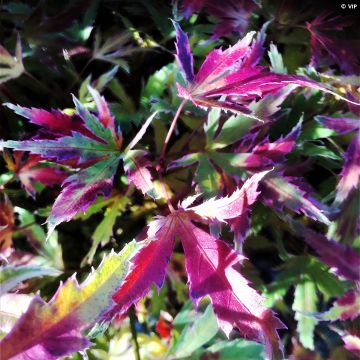

Tilia cordata Girard's Pendula Nana - Small-leaved Lime
Tilia cordata Girard's Pendula Nana - Small-leaved Lime
Tilia cordata Girard's Pendula Nana
Small-leaved Lime, Littleleaf Linden
Why not try an alternative variety in stock?
View all →This plant carries a 24 months recovery warranty
More information
We guarantee the quality of our plants for a full growing cycle, and will replace at our expense any plant that fails to recover under normal climatic and planting conditions.
Oversize package: home delivery by special carrier from €6.90 per order..
Express home delivery from €8.90.
Does this plant fit my garden?
Set up your Plantfit profile →
Description
Tilia cordata 'Girard's Pendula Nana' is a rare variety of Small-leaved Lime tree with a weeping form. It shares similarities with the variety 'Lico': very small, reaching 3 to 4 m in height at maturity, tiny leaves, golden branches. The structure of this small deciduous tree is reminiscent of a bonsai and its golden branches are visible in winter after the leaves have fallen. This miniature cultivar is suitable for small gardens and rockeries. It is not demanding in terms of soil as long as it remains moist, and it tolerates both sea spray and urban pollution.
Tilia cordata (synonym Tilia parviflora) belongs to the Tiliaceae family and is native to European forests. It is a deciduous species that thrives in partial shade and can grow to be over 30 m tall with a wide canopy. It is found in the hill and mountain zones, growing up to 1500 m altitude, usually in moist, deep, fertile, acidic to neutral soil. It has excellent longevity.
The 'Girard's Pendula Nana' cultivar is an American selection made by Girard Nurseries in Ohio, before 1976. This tree has a slow growth rate and reaches a mature size of 3 to 4 m in all directions. It forms a small weeping tree with a slightly rounded shape. Its bark, when mature, is dark brown and channelled, while the smooth young branches are yellowish-green. Its entire, alternate leaves are particularly small, measuring 3 to 6 cm in length. They are rounded, heart-shaped at the base, pointed at the tip, finely toothed along the edges, and green. The leaves turn golden yellow in autumn and fall quite early in the season. Flowering occurs in early summer, in June-July. Numerous small, white-yellowish flowers are gathered in pendulous corymbs, in groups of 15 to 20, and attached to the branches by long petioles. They are remarkably fragrant and a delight for bees. They are followed by small, smooth, grey, globular fruits attached to a wing called a samara.
The 'Girard's Pendula Nana' Lime tree is an interesting small tree for its weeping form, small size, and beautiful branches. Place it where space is limited: in front of a house, in a courtyard, on a rooftop terrace. It is easy to grow in many regions. It can also be planted as a specimen tree in a very small garden. Its fragrant early summer flowering is nectar-rich. Since it also thrives in moist soil, near a water source, it makes for an interesting focal point. In a Japanese garden or rockery, it can be paired with conifers, and its bonsai-like structure can be admired in winter.
Report an error about the product description
Plant habit
Flowering
Foliage
Botanical data
Tilia
cordata
Girard's Pendula Nana
Tiliaceae
Small-leaved Lime, Littleleaf Linden
Cultivar or hybrid
Other Tilia - Linden
Planting and care
Tilia cordata 'Girard's Pendula Nana' is best planted in autumn or spring. It is hardy and not very demanding in terms of soil. It tolerates wind and salt spray quite well. It requires a sunny exposure or, at worst, semi-shade. It dislikes too dry soils but tolerates both acidic and calcareous soils as long as they are not too poor. A deep, fertile and moist soil, well loosened, will ensure optimal growth.
Planting period
Intended location
Care
This item has not been reviewed yet - be the first to leave a review about it.
Striking foliage shrubs
Haven't found what you were looking for?
Hardiness is the lowest winter temperature a plant can endure without suffering serious damage or even dying. However, hardiness is affected by location (a sheltered area, such as a patio), protection (winter cover) and soil type (hardiness is improved by well-drained soil).

Photo Sharing Terms & Conditions
In order to encourage gardeners to interact and share their experiences, Promesse de fleurs offers various media enabling content to be uploaded onto its Site - in particular via the ‘Photo sharing’ module.
The User agrees to refrain from:
- Posting any content that is illegal, prejudicial, insulting, racist, inciteful to hatred, revisionist, contrary to public decency, that infringes on privacy or on the privacy rights of third parties, in particular the publicity rights of persons and goods, intellectual property rights, or the right to privacy.
- Submitting content on behalf of a third party;
- Impersonate the identity of a third party and/or publish any personal information about a third party;
In general, the User undertakes to refrain from any unethical behaviour.
All Content (in particular text, comments, files, images, photos, videos, creative works, etc.), which may be subject to property or intellectual property rights, image or other private rights, shall remain the property of the User, subject to the limited rights granted by the terms of the licence granted by Promesse de fleurs as stated below. Users are at liberty to publish or not to publish such Content on the Site, notably via the ‘Photo Sharing’ facility, and accept that this Content shall be made public and freely accessible, notably on the Internet.
Users further acknowledge, undertake to have ,and guarantee that they hold all necessary rights and permissions to publish such material on the Site, in particular with regard to the legislation in force pertaining to any privacy, property, intellectual property, image, or contractual rights, or rights of any other nature. By publishing such Content on the Site, Users acknowledge accepting full liability as publishers of the Content within the meaning of the law, and grant Promesse de fleurs, free of charge, an inclusive, worldwide licence for the said Content for the entire duration of its publication, including all reproduction, representation, up/downloading, displaying, performing, transmission, and storage rights.
Users also grant permission for their name to be linked to the Content and accept that this link may not always be made available.
By engaging in posting material, Users consent to their Content becoming automatically accessible on the Internet, in particular on other sites and/or blogs and/or web pages of the Promesse de fleurs site, including in particular social pages and the Promesse de fleurs catalogue.
Users may secure the removal of entrusted content free of charge by issuing a simple request via our contact form.
The flowering period indicated on our website applies to countries and regions located in USDA zone 8 (France, the United Kingdom, Ireland, the Netherlands, etc.)
It will vary according to where you live:
- In zones 9 to 10 (Italy, Spain, Greece, etc.), flowering will occur about 2 to 4 weeks earlier.
- In zones 6 to 7 (Germany, Poland, Slovenia, and lower mountainous regions), flowering will be delayed by 2 to 3 weeks.
- In zone 5 (Central Europe, Scandinavia), blooming will be delayed by 3 to 5 weeks.
In temperate climates, pruning of spring-flowering shrubs (forsythia, spireas, etc.) should be done just after flowering.
Pruning of summer-flowering shrubs (Indian Lilac, Perovskia, etc.) can be done in winter or spring.
In cold regions as well as with frost-sensitive plants, avoid pruning too early when severe frosts may still occur.
The planting period indicated on our website applies to countries and regions located in USDA zone 8 (France, United Kingdom, Ireland, Netherlands).
It will vary according to where you live:
- In Mediterranean zones (Marseille, Madrid, Milan, etc.), autumn and winter are the best planting periods.
- In continental zones (Strasbourg, Munich, Vienna, etc.), delay planting by 2 to 3 weeks in spring and bring it forward by 2 to 4 weeks in autumn.
- In mountainous regions (the Alps, Pyrenees, Carpathians, etc.), it is best to plant in late spring (May-June) or late summer (August-September).
The harvesting period indicated on our website applies to countries and regions in USDA zone 8 (France, England, Ireland, the Netherlands).
In colder areas (Scandinavia, Poland, Austria...) fruit and vegetable harvests are likely to be delayed by 3-4 weeks.
In warmer areas (Italy, Spain, Greece, etc.), harvesting will probably take place earlier, depending on weather conditions.
The sowing periods indicated on our website apply to countries and regions within USDA Zone 8 (France, UK, Ireland, Netherlands).
In colder areas (Scandinavia, Poland, Austria...), delay any outdoor sowing by 3-4 weeks, or sow under glass.
In warmer climes (Italy, Spain, Greece, etc.), bring outdoor sowing forward by a few weeks.
















































